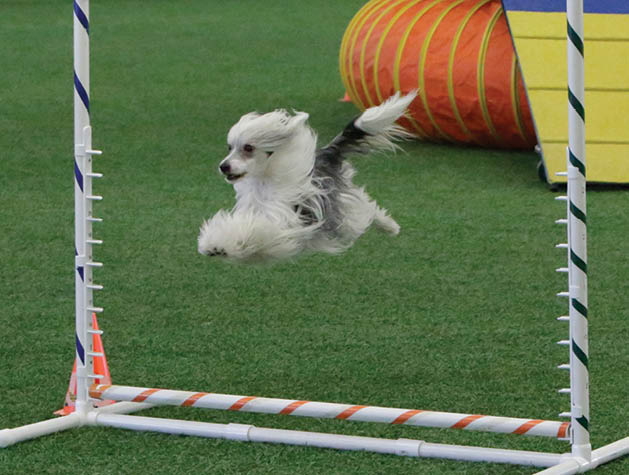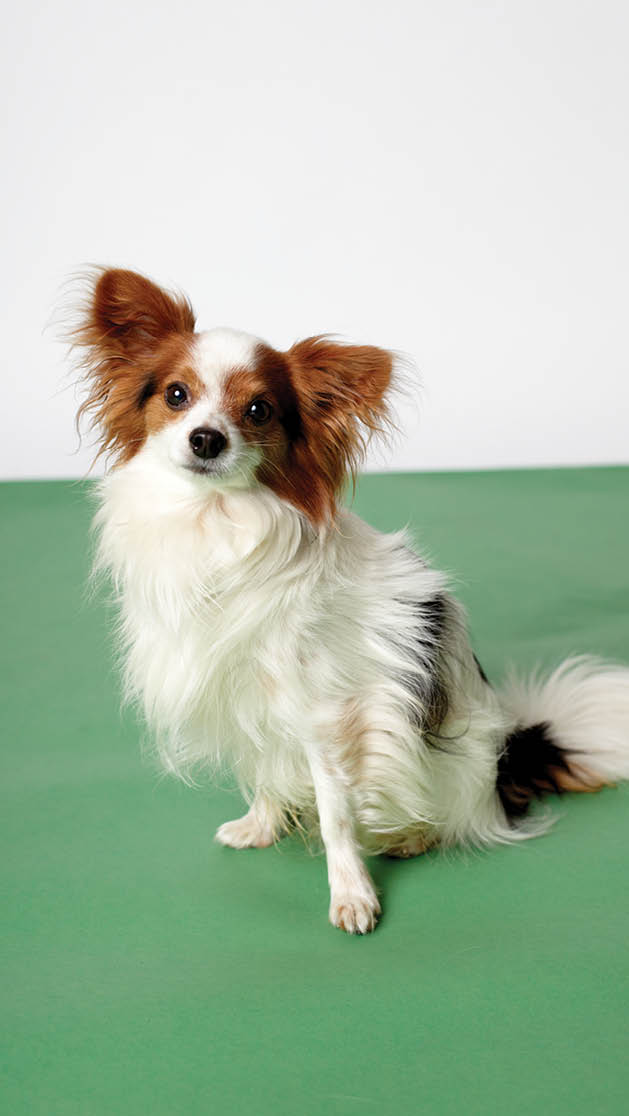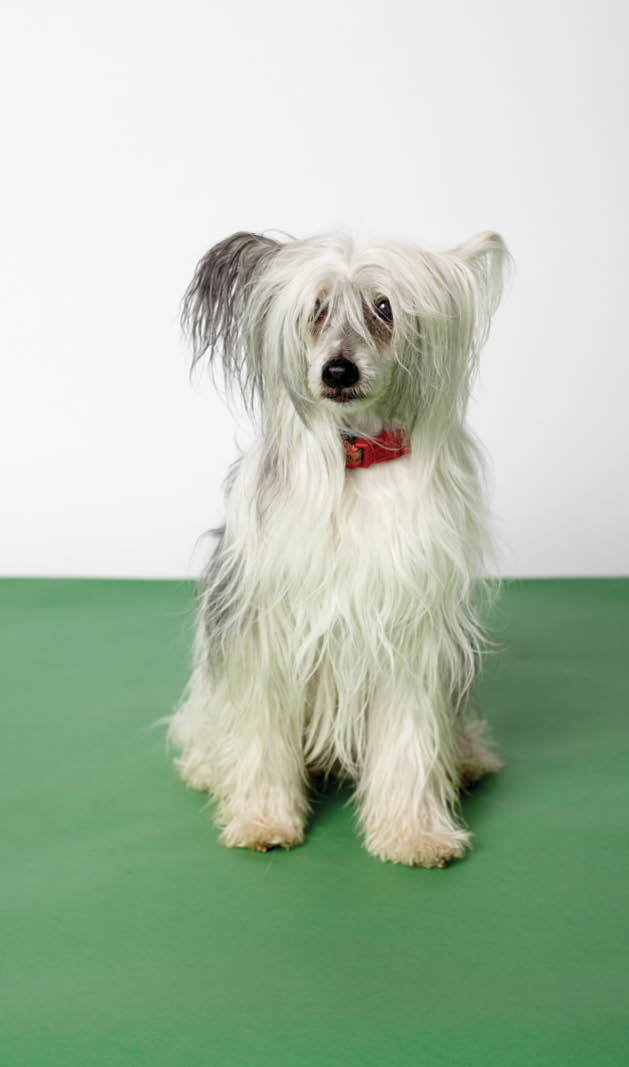Edina residents love their dogs. You never have to go too far to see a pooch out on the town—walking, sniffing, running or playing.
But some dog owners want to help their pets rise to the next level, and even some “ordinary” household pets can become award-winning champions in an interesting arena: dog agility. As we learned from these local experts, great things can happen with some training, practice, competitive drive and some fun thrown in for good measure, although strong discipline is a must.
In the sport of dog agility, handlers guide their dogs through a challenging course, and all participants are put to the test. Dog and handler work together to achieve the highest marks possible, based on accuracy and speed. Dog agility combines athletic skill with attentiveness and a little crowd-pleasing showmanship. Read on to learn more about some of Edina’s agile dogs.

Karin Overstreet
Murphy the Westie
While West Highland white terriers, commonly known as Westies, are rarely agility front-runners, Murphy is a rock-star performer. A passion for precision and a pleasing personality make him a paws-on performer. His owner and handler, Edina resident Karin Overstreet, takes pride in the accomplishments she and Murphy have achieved in dog agility competitions in Minnesota.
A spitfire of gleaming white fur, Murphy has a big dog personality in a pint-sized frame. After success in obedience training, he moved on to puppy agility training at the tender age of 6 months. With his exacting nature, Murphy displayed a knack for agility from the start. Mistakes on the course rarely happened.
Obstacles that often hinder other dogs, like weave poles, came naturally to Murphy. The motion of threading in and out of weave poles is not a natural movement for a dog. “The weaves are one of the harder things to learn. Once they master them, they know them for life,” says Overstreet.
Today, at the more mature age of 5, Murphy still enjoys agility and looks forward to his advanced training at Bloomington Obedience Training Club. Canine instinct kicks in like clockwork. When training time rolls around, Murphy will be ready with an enthusiastic wag. “He knows which day of the week his class is. He’ll come find me on Wednesdays,” Overstreet says.
Murphy’s eagerness to please and his energetic nature has made him a winner. This accomplished canine has won “tons of ribbons” in agility, says Overstreet. A rainbow of gleaming awards attest to his true talent. “He’s won different trial agility canine performance events,” Overstreet says. After winning in Canine Performance on one level, you go to the next and the next. “He’s placed in level four agility trials.”
Through his many triumphs in dog agility, Murphy has developed a strong sense of discipline. “He’ll sit even during a full run if I say, ‘Sit,’ ” Overstreet says.
Agility training can help develop a pack hierarchy with the handler as leader. “Agility is a great way to develop a strong relationship with your dog, and shows them who is master of the house,” says Overstreet. “It’s really a partnership between you and your dog.”
Rewards? Food is not allowed during the actual competition, but Murphy does get treats during his routine agility training. “My dog loves cheese,” says Overstreet.
The opportunity to interact with a dog makes agility a fun sport. Overstreet encourages others to do activities with their dogs. Busy dogs tend to be happier dogs. “It’s good to do stuff with your pet,” Overstreet says.
While agility training and competition is good, even routine walks are beneficial. “Edina is a great place with lots of parks,” says Overstreet.
Wayne Carlson
Wayne Carlson trains national champion agility dogs and loves every minute of it. Dog agility can get into your blood. “I’m kind of nuts about this,” says Carlson.
He and Rosie Horner, who is a dog owner, are Edina residents with a winning formula for dog agility. Their dogs are champions. “They [have] all kinds of titles and bars. I could make blankets and robes out of them if I wanted to,” Carlson says.
In keeping with his positive training philosophy, Carlson always ends training on a good note. When his dogs get things right, the training stops. Positive training techniques reinforce good behavior. Carlson does training regularly at places like Agile Canines in Minneapolis and the Bloomington Obedience Training Club. Several days a week, he devotes quality time to his dogs’ agility work.
Until a few years ago, Carlson was not familiar with dog agility and was a very unlikely candidate for the sport. He says, “I hated dogs. I like cats. [Horner] got a dog to fit in her purse.”
But then one dog lead to another, and the dogs needed a group activity. Horner asked Carlson, “Why don’t you teach them to sit, stay and be sociable?”
The dogs took to their training, mastered basic skills and moved on to dog agility. Carlson bonded with his dogs, and the pack—Casanova, Pearlina and Bogart—became winners. “It’s more than training. It’s teamwork,” Horner says.
Much like human athletes, massage helps keep Casanova, Pearlina and Bogart flexible and helps prevent injuries; plus, they love it, according to Carlson. “I start with one dog and they are in line waiting for a massage.”
Agility has benefits for dogs and dog owners alike. The exercise is good for both. The rigors of dog agility training helped Carlson drop 40 pounds. For the dogs, time with their handler is fun and provides good discipline. “It’s actually in your dog’s best interest to do agility,” Carlson says, “It’s too big a world for a dog to be in charge.”



Casanova the papillon
Casanova is no ordinary dog. This papillon (the word means “butterfly” in French) can do extraordinary things, all with a fringe of fur flowing behind his regal ears. With an open agility standard title and a boatload of other awards to his credit, Casanova is a much bigger deal than his toy dog bark might suggest.
Now at 8 years old, Casanova ranks as the “most titled dog in the state of Minnesota,” says Carlson. A short list of his impressive accomplishments includes weight pulling, working as a therapy dog, barn hunter and pretty good agility dog. “He can pull 1,001 pounds. It’s amazing to watch,” Carlson says.
Pearlina the Pomeranian
Don’t underestimate this teacup pup. Pearlina is no powder puff, even though she is killer-cute. Star-quality accomplishments make Pearlina a one-of-a-kind dog on a grand scale. She earned a notable achievement award in 2011 and 2012 as the No. 1 nationally preferred Pomeranian.
A severe injury to her kneecap in 2012 kept her down for a while, but she made a comeback. Nothing can hold Pearlina down for long. This dog has spunk and excels in agility.
“She’s very, very consistent,” Carlson says, “She is a pretty fantastic little dog.”
Bogart the Chinese crested
A wow factor and love of showmanship make Bogart a stand-out dog in any crowd. For agility, he’s in it for the glory. “He doesn’t want to work hard. He really likes victory laps. He can move three times as fast in a victory lap as what he did to get there,” says Carlson.
Elegant, free-flowing fur cloaks this all-athlete dog. Bogart has a mane like a thoroughbred horse and a stride to match. “He’s very good at the distance stuff. He has run faster than an Australian shepherd,” Carlson says.
Rules of the Agility Game
Dogs prove their stuff during trials and compete based on their size. During competition, they must complete a rigorous course of obstacles. A savvy agility handler guides a dog’s every step. Typically, handlers run along with their dogs, using a combination of hand gestures and verbal commands to get the dog to do the right thing.
Some dogs, like border collies, can achieve success with hand and verbal commands alone. When a handler can work just from the center of the course, it is really something to see, according to Overstreet.
Racing against the clock, dogs work their way through a maze of obstacles. Challenges unfold at every turn. Winding tunnels, seesawing teeter-totters, tall A-frame bridges, skinny dog-walk planks, hanging tire jumps, zigzag lines of weave poles and other hurdles challenge their every step.
Breeds
Never judge a dog by its size or demeanor. Even the smallest teacup-sized breed can become a top dog. Star athletes come from a surprising range of dog breeds, from extra big to teeny-tiny. Even good old American mutts can shine in agility.
Any healthy, trained dog has agility potential, although some breeds, builds and personalities are more likely to enjoy the game. A people-pleasing personality, herding instinct and prey drive are known attributes for agility. Active working breeds have the strength and energy level for the sport. German shepherds, Australian shepherds, Australian kelpies, standard poodles, papillons, Pomeranians and even pugs have winning reputations. Still, there are many exceptions, and no hard-and-fast rules for which dogs can participate, as long as they are fit and are good canine citizens.
What does “properly trained” mean? A well-behaved dog can sit, stay, retrieve and recall—and is generally polite and friendly. An inclination to bite, of course, is a big no-no in the agility world. Mastering basic dog obedience is a logical first step before getting into the demands of agility. Wayne Carlson recommends starting things off right with puppy training. But with persistence, even older dogs can learn new tricks.






